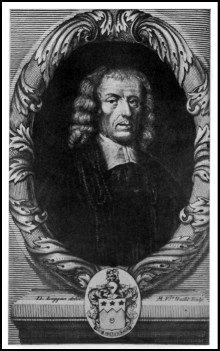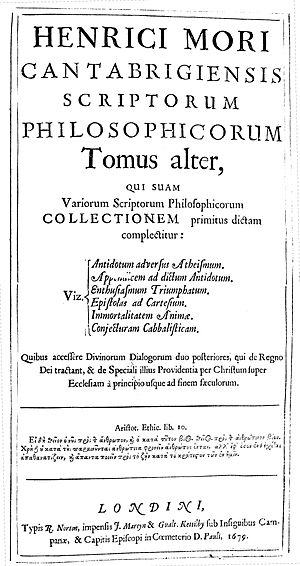Henry More facts for kids
Henry More (born October 12, 1614 – died September 1, 1687) was an English thinker and writer. He was part of a group called the Cambridge Platonists, who were philosophers at Cambridge University.
Contents
Henry More's Life Story
Henry More was born in Grantham, Lincolnshire, England, on October 12, 1614. He was the seventh son of Alexander More, who was the mayor of Grantham. His parents were Calvinists, a type of Protestant Christian. However, Henry himself found some of their beliefs difficult to accept.
He went to school at The King's School, Grantham and then at Eton College. In 1631, he started studying at Christ's College, Cambridge. He earned his first degree in 1635 and his master's degree in 1639. Right after that, he became a fellow at his college, which meant he was a senior member of staff. He turned down other job offers, including the chance to become the head of his college in 1654. Later, in 1675, he accepted a church position in Gloucester Cathedral, but he quickly gave it to his friend, Edward Fowler.
More taught many important students. One of them was Anne Finch, who later became Lady Conway. Henry More spent a lot of time at her home, Ragley Hall, in Warwickshire. Both Lady Conway and her husband respected him greatly. He wrote several of his books while staying in the peaceful woods there. Lady Conway's strong spiritual beliefs influenced some of More's ideas. She eventually joined the Quakers, a Christian group. Ragley Hall became a place where people gathered for religious and spiritual discussions.
Henry More's Ideas and Beliefs
Henry More was a rationalist theologian. This means he used reason and logic to understand religious ideas. He tried to use the scientific ideas of his time, especially those from René Descartes, to prove that things without physical bodies, like spirits, truly exist.
More disagreed with some of Descartes's ideas about how the mind and body work. Descartes believed the mind was completely separate from the body and didn't take up space. More found this hard to accept. He thought that if something truly exists, it must take up some kind of space, even if it's a spirit. He even came up with the idea of a "fourth dimension" where spirits could exist and have a kind of "thickness." This was his unique way of explaining how the mind and body could interact.
Henry More's Impact
Henry More is often linked to a famous saying about medieval scholars. He suggested they debated useless questions, like "how many angels can dance on the head of a pin." He wrote this in his book The Immortality of the Soul.
A quote from More is used at the beginning of "The Over-soul," an essay by the famous American writer Ralph Waldo Emerson.
Helena Blavatsky, who started the spiritual movement called Theosophy, also quoted Henry More and explained his ideas in her book Isis Unveiled.
Henry More's Writings
Henry More wrote many books and poems. His book Divine Dialogues (published in 1688) shares his main ideas about philosophy and religion. Like many writers, he started by writing poetry and later focused on prose (regular writing).
His first work, published in 1642, was a collection of poems called Psychodoia Platonica: or, a Platonicall Song of the Soul. In 1647, he published a larger collection called Philosophical Poems.
Some of his other important prose works include:
- An Antidote against Atheism (1653): This book argued for the existence of God.
- Conjecture Cabbalistica (1653): This work explored ways to understand the ideas of Moses.
- Enthusiasmus Triumphatus (1656): This book discussed the nature and causes of strong religious feelings.
- The Immortality of the Soul (1659): This book argued that the human soul lives on after the body dies.
- An Explanation of the Grand Mystery of Godliness (1660): This work explained the Christian Gospel.
- Enchiridion Ethicum (1667): This book was about moral philosophy.
- Divine Dialogues (1668): This book presented his philosophical and religious views through conversations.
- Enchiridion Metaphysicum (1671): This book was a critique of Descartes's philosophy.
More also helped edit other books, like Joseph Glanvill's Saducismus Triumphatus (1681), which was about witchcraft and spirits. Henry More believed in witchcraft and apparitions (ghosts).
He published complete collections of his works in Latin, including Opera theologica in 1675 and Opera philosophica in 1678. Many of his English works were translated into Latin during this time.
See also
 In Spanish: Henry More para niños
In Spanish: Henry More para niños



